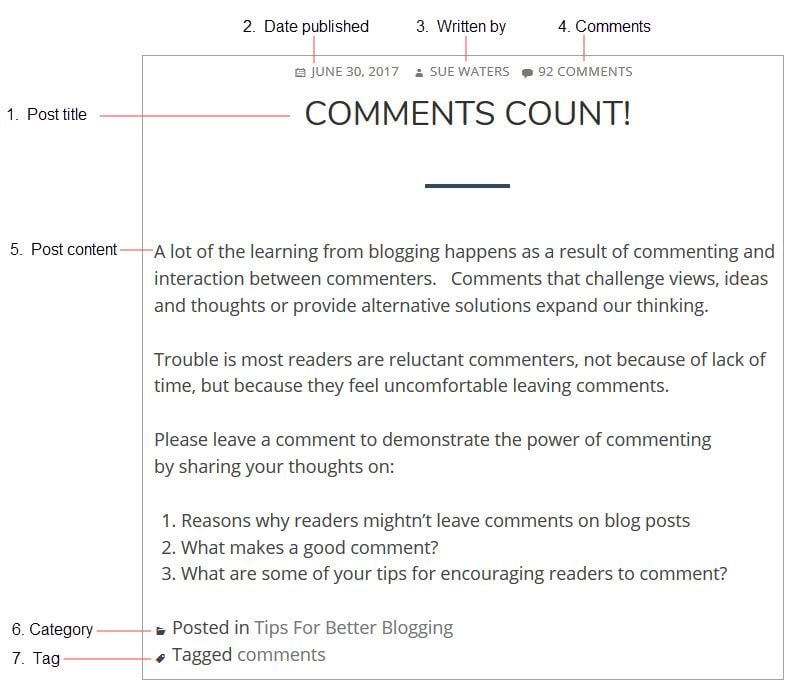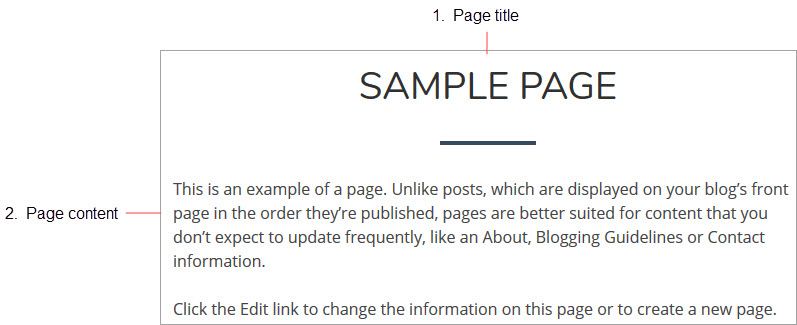Sites are composed of two main structures: post and pages.
At first, understanding the difference between posts and pages can be confusing.
Think of pages as your static content or “one-off” kind of content that will seldom need changing. This might for example be your About page, and is seen as timeless entities.
Posts on the other hand are your blog entries or dynamic content that gets added regularly. Lets have a look at the two in more detail.
WHAT’S ON THIS PAGE?
INTRODUCTION TO POSTS
Your posts are where you’ll publish your main content such as what’s been happening in class. assignment information, documents, and more. Posts are commonly displayed in reverse-chronological order with the most recent post at the top of the page.
By default, your home page is your blog post page and this is where you’ll see your new posts published. If you want your posts to appear on a page other than your homepage refer to:
If you look closely at a post you will see it is normally made up of:
- Post Title – tells the reader what the post is about. A great post title grabs readers attention and is more likely to encourage them to read your post.
- Date published – all posts display the date a post was published. You’ll normally see this displayed at the top of the post.
- Written by – most themes display the name of the post author. Your username is automatically displayed unless you have changed your display name.
- Comments – all themes have a link to comments. This is where your readers can click to write a comment in response to your post. Comments allow readers, to engage in discussions, share their thoughts and connect with your site.
- Your post content – this is the main information that you want to share or reflect on with your readers
- Categories – are used to help readers locate posts on your site. Categories are often used like chapters of a book; they provide a general overview of the topics you blog about.
- Tags – are used to help readers locate posts on your site. Tags are more like the index at the back of the book and explode the topic into a million bits.

INTRODUCTION TO PAGES
Pages are normally used for information that you want to share with your readers but don’t expect to update frequently.
Commonly used pages on educational sites are:
- The About page. Your About Page is used for telling readers more about yourself and your blog.
- Blogging Rules and Guidelines (here’s how to create Blogging Rules and Guidelines).
- Contact page (here’s how to create a Contact page).
The main things to remember are:
- Pages are best suited for information you rarely update such as your About, Contact and Blogging Guidelines pages.
- Situations where you want readers to discuss a question or topic are better suited to publish as a post and not a page.
- Assignment and homework information is normally best published as posts and not on a page.
- Too many pages can make information harder to manage and find.
If you look closely at a page you will see it is normally made up of:
- Page Title – tells the reader what the page is about.
- Your page content – this is information you want to share on this page
- Comments – most themes support comments at the bottom of the page. Comments are disabled on pages by default and can be enabled.

POSTS VS PAGES
These are the key differences between pages and posts that are important to understand when working with them.
| Properties of a Page | Properties of a Post |
| Blog pages are displayed independently of post history and are more static. They remain the same from day to day since they are rarely updatedNormally used for information that you want to share with readers but don’t expect to update frequently.Pages don’t have time stamps so don’t show the date they are published.Blog pages can appear any where in your blog depending on your theme.You can change the order pages appear.You can’t assign category and tags to pages.Pages don’t appear in RSS feeds so readers need to visit your blog to view latest page updates.You can create sub-pages which you assign to a parent page to create nested pages. | Blog posts appear in reverse chronological order so that the most recent post is the first post that your readers see.Post are dynamic and updated regularly.Posts have a time stamp which displays the date and time the post was published.You can assign categories and tags to posts which make them easier to find.Posts appear in RSS feed so readers who subscribe to your blog will receive your latest post in their RSS reader.Posts display the name of the post author. |